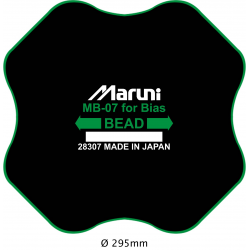Ilość
New Products
Tire repairs materials
expand_moreexpand_lessWeights for wheel balancing
expand_moreexpand_lessValves
expand_moreexpand_lessConsumables
expand_moreexpand_lessTools
expand_moreexpand_lessTPMS
expand_moreexpand_lessCar air conditioning
expand_moreexpand_lessCompressors and pneumatics
expand_moreexpand_lessWorkshop equipment
expand_moreexpand_lessAccessories for Workshop Equipment
Outlet
Recommended
Brands
expand_moreexpand_less
MARUNI MB-07 295mm BIAS PATCH
Quantity
BIAS PATCH MARUNI MB-07 295mm
MB/MS Patches for Repairing Diagonal Tires
MB/MS patches are used for repairing diagonal (bias-ply) tires, ranging from passenger vehicles to construction machinery.
They are made of a reinforced rubber compound and ultra-durable internal nylon fibers.
The outer surface is coated with a protective layer that safeguards against high temperatures.
They are easy to apply, and the vulcanizing adhesion reaction occurs quickly and reliably.
MB/MS patches can be used for hot repairs.
For best results, use with Super Valkarn vulcanizing cement and SEALINER.
-
MS patches should be used for sidewall repairs.
-
MB patches should be used for all other areas of the tire.
How to Repair a Diagonal Tire Using the Cold Repair Method
Required materials:
-
Super Valkarn vulcanizing cement
-
MB patch for diagonal tires
-
STEM repair plug
-
Buffer spray for roughening
-
Sealiner
Step-by-step instructions:
- Use pliers to remove any foreign objects from the puncture and mark the damage area with chalk.
- Drill the damaged area multiple times from both the outside and inside of the tire using a carbide cutter.
- Thread the plug through a plug-puller (unnecessary for new-type plugs with guide wire).
- Remove the protective film from the STEM plug and coat it with Super Valkarn vulcanizing cement.
- Apply a small amount of Super Valkarn vulcanizing cement into the puncture channel.
- If using a plug without a guide wire, insert it using the plug-puller.
- Pull the plug through the tire using pliers from the outside. A section of the plug should protrude on the inner side.
- Cut the inner end of the plug so that it sticks out 2–3 mm from the tire surface.
- Position the patch on the inner tire wall and mark an area slightly larger than the patch using chalk. Make sure the directional arrows point toward the tire bead.
- Apply Liquid Buffer to the marked area to clean and chemically roughen the surface. Remove any





